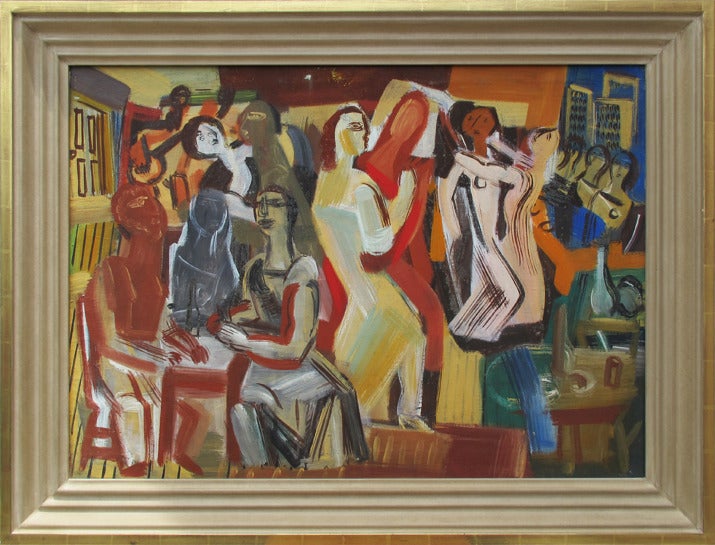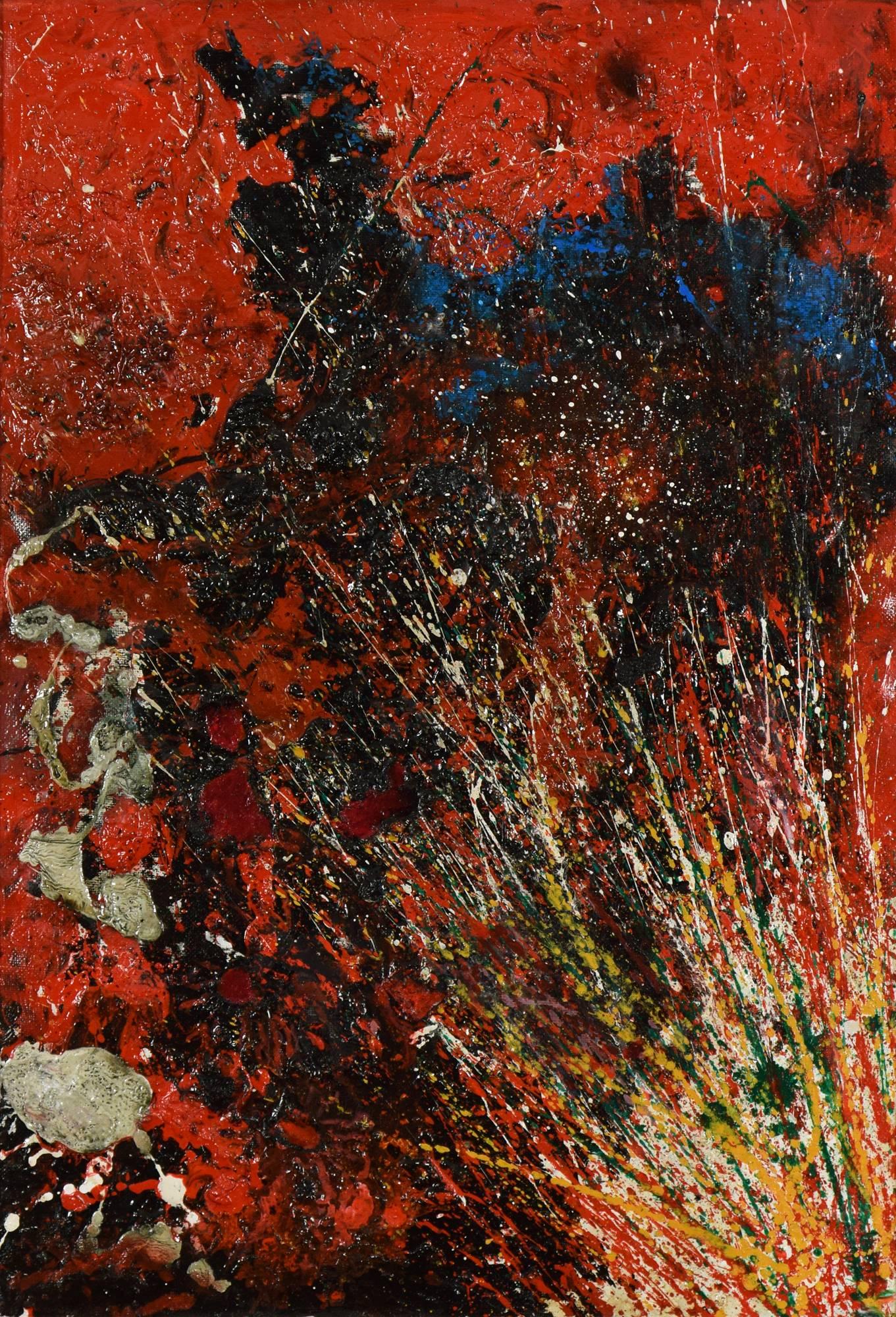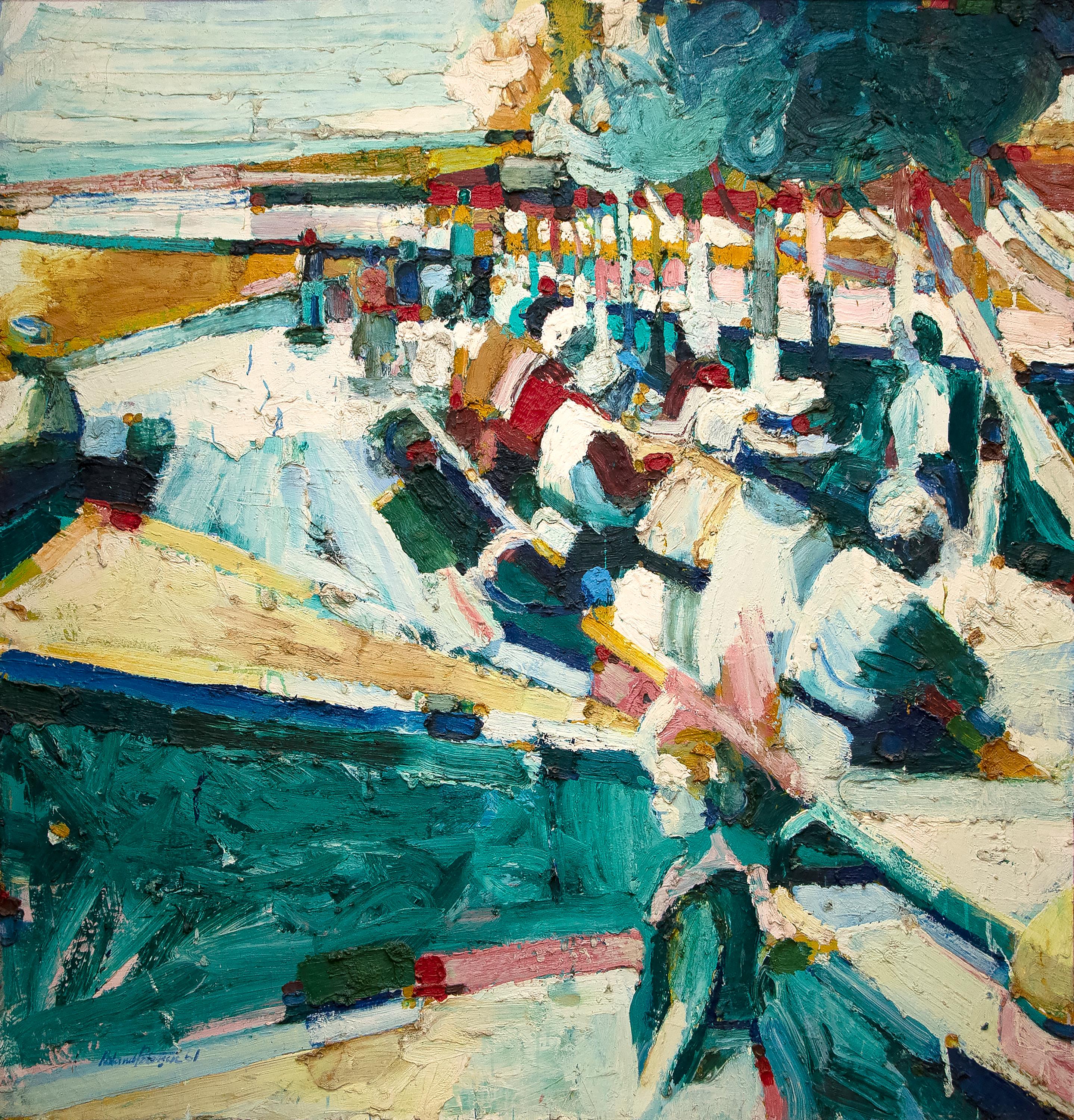Items Similar to Untitled
Video Loading
Want more images or videos?
Request additional images or videos from the seller
Paul BrachUntitled1951
1951
About the Item
Oil on canvas. Signed and dated lower right.
41.75 x 61 in.
44 x 63 in. (framed)
Custom framed in a hardwood floater with a matte white finish.
Provenance
Estate of the artist
Eric Firestone Gallery, New York
Born in New York, Paul Brach propelled American art forward through his own contributions as an Abstract Expressionist, Minimalist, art educator, and valued mentor. Brach grew up riding horses and working on ranches, experiences that influenced his work throughout his career. While studying at the University of Iowa under Grant Wood, Brach was called to the military and served in the U.S. Army as an infantryman for three years during World War II. After completing his formal art education and his first teaching experience in the Midwest, Brach returned to New York with his wife, the artist Miriam Schapiro.
Brach frequented the notorious Cedar Bar and quickly became associated with second-generation Abstract Expressionism, both socially and through his own interpretation of painterly abstraction.
In 1957, Leo Castelli opened his famed gallery at 4 East 77th Street on the Upper East Side. Brach was the third artist to enjoy a solo exhibition at Castelli Gallery, which ran from April to May of 1957. For the better part of the next decade, Brach would show with many of the artists who would come to be known as titans of the American post-war era: Willem de Kooning, Jackson Pollock, Morris Louis, Robert Rauschenberg, and many others.
In 1967, Brach moved to San Diego, accepting the offer to be chairman of the new art department at the University of California San Diego. Two years later, Brach moved on to the California Institute of Arts in Los Angeles, becoming the first dean of their art school. Integral to the program, Brach assembled an incredible faculty, which included Allan Kaprow, Nam June Paik, and Miriam Schapiro, while also fostering an environment in which artists like David Salle, Eric Fischl, and Jack Bloom could develop and flourish. Along with the educational renaissance Brach was leading, his studio practice evolved toward minimalism, with his paintings beginning to favor subtle palettes and quiet compositions.
In 1975, Brach and Schapiro returned to New York where he assumed the directorship of the Arts Division at Fordham University. Some years later, Brach eschewed academia in favor of a studio practice, which he maintained for the rest of his life.
Brach showed with various galleries until 1998, when he and Schapiro permanently relocated to East Hampton, where they remained until his death in 2007. Brach's work can be found in many public and private collections worldwide, including the Museum of Modern Art, the Whitney Museum of American Art, the Amon Carter Museum of Art, and the Smithsonian, among others.
Source: Eric Firestone Gallery
- Creator:Paul Brach (1924 - 2007, American)
- Creation Year:1951
- Dimensions:Height: 41.75 in (106.05 cm)Width: 61 in (154.94 cm)
- Medium:
- Movement & Style:
- Period:
- Condition:Overall good and stable condition. No evidence of restoration. Not examined under UV light. Please contact for full condition report and additional photos.
- Gallery Location:Austin, TX
- Reference Number:1stDibs: LU2287214215172
About the Seller
No Reviews Yet
Vetted Seller
These experienced sellers undergo a comprehensive evaluation by our team of in-house experts.
Established in 2020
1stDibs seller since 2023
- ShippingRetrieving quote...Ships From: Austin, TX
- Return PolicyA return for this item may be initiated within 30 days of delivery.
More From This SellerView All
- UntitledBy Norman CartonLocated in Austin, TXOil on canvas. Signed lower right, signed and sequentially numbered on verso. 44 x 30.25 in. 47.5 x 33.75 in. (framed) Custom framed in a two-tiered matte white hardwood tray frame. Provenance Estate of Norman Carton Norman Carton was born in the Ukraine, eventually immigrating to the U.S. in 1922 and settling in Philadelphia, where he attended the Pennsylvania Museum School of Industrial Art. In the 1930s, he received a scholarship to attend the Pennsylvania Academy of Fine Arts (PAFA). Between 1939 and 1942, the Works Project Administration (WPA) employed Carton as a muralist. During World War II, Carton was a naval structural designer and draftsman at the Cramps...Category
1970s Abstract Expressionist Abstract Paintings
MaterialsCanvas, Oil
- UntitledBy Michael GoldbergLocated in Austin, TXOil, pastel, and paper collage on canvas. Signed and dated verso. 52.75 x 47.75 in. 54 x 49 in. (framed) Gilded floater frame. Provenance Compass Rose, Chicago Born Sylvan Irwin Goldberg in 1924 and raised in the Bronx, Michael Goldberg was an important figure in American Abstract Expressionism, who began taking art classes at the Art Students League in 1938. A gifted student, Goldberg finished high school at the age of 14 and enrolled in City College. He soon found New York’s jazz scene to be a more compelling environment, and he began skipping classes in favor of the Harlem jazz clubs near campus. Goldberg’s love of jazz would become a lifelong passion and a key component to his approach to composition in his paintings. From 1940 to 1942, like many of the leading artists of the New York School, Goldberg studied with Hans Hofmann. In 1943, he put his pursuit of painting on hold and enlisted in the U.S. Army. Serving in North Africa, Burma, and India, Goldberg received a Purple Heart and a Bronze Star before being discharged in 1946. After his service, he traveled and worked in Venezuela before returning to the United States, settling back in New York and resuming studies with Hofmann and at the Art Students League. Living downtown and frequenting the Cedar Bar, Goldberg befriended many of the artists of the New York School. In 1951, his work was included in the groundbreaking Ninth Street Show, co-organized by Leo Castelli, Conrad Marca-Relli, and the Eighth Street Club, and featuring the work of - among others - Hofmann, Jackson Pollock, Willem de Kooning, and Franz Kline. In 1953, the Tibor de Nagy...Category
1980s Abstract Expressionist Abstract Paintings
MaterialsCanvas, Pastel, Mixed Media, Oil, Handmade Paper
- Paysage aux RochersBy Gabriel GodardLocated in Austin, TXOil on canvas. Signed and dated lower left. 51 x 38 in. 52.5 x 39.25 in. (framed) Framed in maple. Gabriel Godard, a self-taught painter, was born in 1933 in Delouze, France. Hist...Category
1960s Abstract Expressionist Abstract Paintings
MaterialsCanvas, Oil
- Blue GreyBy Philippe HosiassonLocated in Austin, TXOil on canvas. Signed and dated lower right and verso, titled verso. 39.25 x 31.75 in. 40.25 x 32.75 in. (framed) Custom framed in maple. Philippe Hosiasson was born and grew up i...Category
1960s Abstract Expressionist Abstract Paintings
MaterialsCanvas, Oil
- UntitledBy John OpperLocated in Austin, TXOil on canvas. Signed lower right, signed and dated verso. 62.25 x 56.25 in. 64 x 58 in. (framed) Custom framed in a natural cherry wood floater. Provenance Washburn Gallery, New York Behnke Doherty Gallery, Washington Depot, CT Born in 1908 in Chicago, John Opper moved with his family to Cleveland, Ohio, in 1916. In high school, he began studying art and attending classes at the Cleveland Museum of Art. After graduation, he enrolled in the Cleveland School of Art (now Cleveland Institute of Art), only to withdraw after a year and move to Chicago, where he took classes at the Art Institute of Chicago. He eventually returned to Cleveland, enrolling at Western Reserve University (now Case Western Reserve), receiving his bachelor’s degree in 1931. The Depression has taken hold during this period, so Opper found work by teaching metalworking and sketching classes at the Karamu Settlement House, the oldest African American theater in the United States. In 1933, Opper traveled to Gloucester, Massachusetts, eventually connecting with the artist Hans Hofmann, who was teaching at the school run by Ernest Thurn. Hofmann encouraged Opper to work “in a more modern vein and start finding what it’s all about.” Heeding this advice, Opper relocated to New York, co-founding a mail-order club of American and British prints for dissemination to schools and museums. By the mid-1930s, he joined the Works Progress Administration (WPA) Easel Division, and also began attending the 57th Street school that Hans Hofmann had established after leaving the Art Students League. Looking back at his time at the school, Opper felt that beyond Hofmann’s teaching, most advantageous was his contact with fellow artists, including Byron Browne, Rosalind Bengelsdorf, and George McNeil. At the time, he also met Giorgio Cavallon and the sculptor Wilfrid Zogbaum. In 1936, Opper became a founding member of the American Abstract Artists, along with Balcomb and Gertrude Greene. The organization was formed to provide an opportunity for artists to show abstract works at a time when such opportunities were scarce. This led to his first solo show in 1937 at the Artists’ Gallery in New York. During his summer in Gloucester in 1933, Opper came to know Milton Avery. Painting in Avery’s informal studio in New York City the following winter, he became acquainted with Adolph Gottlieb and Mark Rothko. Opper participated in a couple of shows during the 1930s of the American Artists Congress Against War and Fascism, whose president was Stuart Davis. About the same period, Opper joined the Artists’ Union and served as the business manager of its publication, Art Front. During World War II, Opper worked for a ship design company creating drawings for piping systems used in PT boats...Category
1950s Abstract Expressionist Abstract Paintings
MaterialsCanvas, Oil
- July FourthLocated in Austin, TXOil on canvas. Signed and titled verso. 40.25 x 56.25 in. 40.75 x 56.75 in. (framed) Custom framed in a whitewashed cherry closed-corner frame. Aaron Levy was born in New York Cit...Category
1960s Abstract Expressionist Abstract Paintings
MaterialsCanvas, Oil
You May Also Like
- Diving for PearlsLocated in New York, NYDiving for Pearls, 1986 Oil on canvas 88 x 76 in. (223.5 x 193 cm) Signed, dated, and titled, versoCategory
1980s Abstract Expressionist Abstract Paintings
MaterialsCanvas, Oil
- James Joyce's SmileLocated in New York, NYJames Joyce's Smile, 1984 Oil on canvas 66 x 87 in. (167.6 x 221 cm) Signed, dated, and titled, versoCategory
1980s Abstract Expressionist Abstract Paintings
MaterialsCanvas, Oil
- Large Scale Mid-Century Earth-tone Horizontal Abstract by Joseph VasicaBy Joseph VasicaLocated in Soquel, CALarge Scale Mid-Century Earth-tone Horizontal Abstract by Joseph Vasica Very large scale (70"H x 160"W) (5.8'H x 13.3'L) mid-century abstract with soft edge, grey and burnt sienna...Category
Mid-20th Century Abstract Expressionist Abstract Paintings
MaterialsCanvas, Oil
- "Manhattan Night Life"By Vaclav VytlacilLocated in Lambertville, NJJim’s of Lambertville is proud to offer this artwork by: Vaclav Vytlacil (1892-1984) He was born to Czechoslovakian parents in 1892 in New York City. Living in Chicago as a youth, he took classes at the School of the Art Institute of Chicago, returning to New York when he was 20. From 1913 to 1916, he enjoyed a scholarship from the Art Students League, and worked with John C. Johansen (a portraitist whose expressive style resembled that of John Singer Sargent), and Anders Zorn. He accepted a teaching position at the Minneapolis School of Art in 1916, remaining there until 1921. This enabled him to travel to Europe to study Cézanne’s paintings and works of the Old Masters. He traveled to Paris, Prague, Dresden, Berlin, and Munich seeking the works of Titian, Cranach, Rembrandt, Veronese, and Holbein, which gave him new perspective. Vytlacil studied at the Royal Academy of Art in Munich, settling there in 1921. Fellow students were Ernest Thurn and Worth Ryder, who introduced him to famous abstractionist Hans Hofmann. He worked with Hofmann from about 1922 to 1926, as a student and teaching assistant. During the summer of 1928, after returning to the United States, Vytlacil gave lectures at the University of California, Berkeley, on modern European art. Soon thereafter, he became a member of the Art Students League faculty. After one year, he returned to Europe and successfully persuaded Hofmann to teach at the League as well. He spent about six years in Europe, studying the works of Matisse, Picasso, and Dufy. In 1935, he returned to New York and became a co-founder of the American Abstract Artists group in 1936. He later had teaching posts at Queens College in New York; the College of Arts and Crafts in Oakland, California; Black Mountain College in North Carolina; and the Art Students League. His paintings exhibit a clear inclination toward modernism. His still lives and interiors from the 1920s indicate an understanding of the art of Cézanne. In the 1930s, his works displayed two very different kinds of art at the same time. His cityscapes and landscapes combine Cubist-inspired spatial concerns with an expressionistic approach to line and color. Vytlacil also used old wood, metal, cork, and string in constructions, influenced by his friend and former student, Rupert Turnbull. He eventually ceased creating constructions as he considered them too limiting. The spatial challenges of painting were still his preference. During the 1940s and 1950s, his works indicated a sense of spontaneity not felt in his earlier work. He married Elizabeth Foster in Florence, Italy, in 1927 and they lived and worked in Positano, Italy for extended periods of time. Later on, they divided their time between homes in Sparkill, New York and Chilmark, Massachusetts, where Vyt, as he was affectionately called, taught at the Martha's Vineyard Art...Category
1930s Abstract Expressionist Abstract Paintings
MaterialsCanvas, Oil
- Red Composition by TOSHIMITSU ÏMAI - Contemporary, Abstract, Oil on canvasBy Toshimitsu ImaiLocated in London, GB*PLEASE NOTE UK BUYERS WILL ONLY PAY 5% VAT ON THIS PURCHASE. Red Composition by TOSHIMITSU ÏMAI (1928-2002) Oil on canvas 80.2 x 55.3 (31 ⅝ x 21 ¾ inches) Signed, TOSHIMITSU IMAÏ, dated, 1963 Paris and inscribed in Japanese on the reverse Provenance Private collection, USA Born in Kyoto, Japan in 1928 Imai was part of the 20th century Japanese avant-garde. He began his formal education at the Tokyo State Art Academy where he took up painting. His early works are characterised by colourful abstractions, reminiscent of Favuism. In 1951 Imai was awarded the Kansai-Shinseisaku Prize and in 1952 the prize for the best new artist at the 15th Shinseisaku Salon. Imai relocated to Paris in 1953, the same and subsequent year he exhibited at the Salon de L’Art Sacré. Meanwhile, he attended the Académie de la Grande Chaumière and the Sorbonne to read medieval history and philosophy. In 1955, Imai completely abandoned representational art in favour of abstraction. After meeting the art critic Michel Tapié via the artist Sam Francis, Imai was the first Japanese artist to join the Art Informel movement. In 1956 Imai was called upon by the Japanese artist Taro Okamoto to curate an exhibition entitled The World: Today’s Art in Tokyo. Artists such as Jean Dubuffet, Jean Fautrier, Lucio Fontana, and Karel Appel gained important exposure in Japan. It was also in 1957, when Imai arranged for Tapié and the artists Georges Mathieu and Sam Francis to travel to Japan, that a connection between Art Informel and Gutai occurred. The Ashiya-based Gutai Art Association formed in 1954 was proclaimed a kindred spirit by Tapié which he subsequently promoted internationally. Founding members included Yoshihara Jiro, Kanayma Akira, Murakami Saburo, Shiraga Kazuo and Shozo Shimamoto...Category
1960s Abstract Expressionist Abstract Paintings
MaterialsCanvas, Oil
- UntitledBy Roland PetersenLocated in Palm Desert, CAA painting by Roland Petersen. This Untitled, oil on canvas, abstract painting is executed in thick and lush impasto, in colors primarily of greens, blues, teals, white, red, ochre a...Category
1960s Abstract Expressionist Abstract Paintings
MaterialsCanvas, Oil





